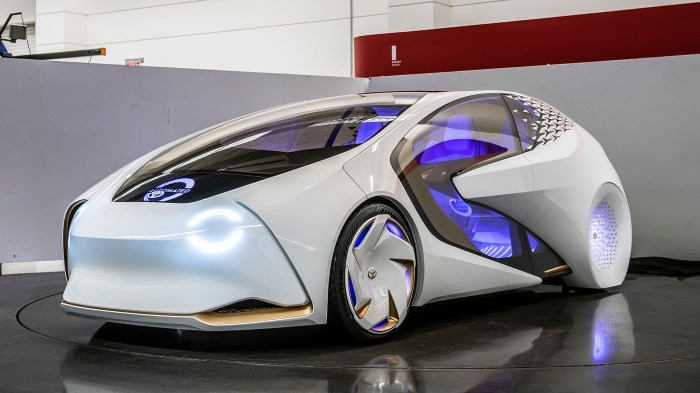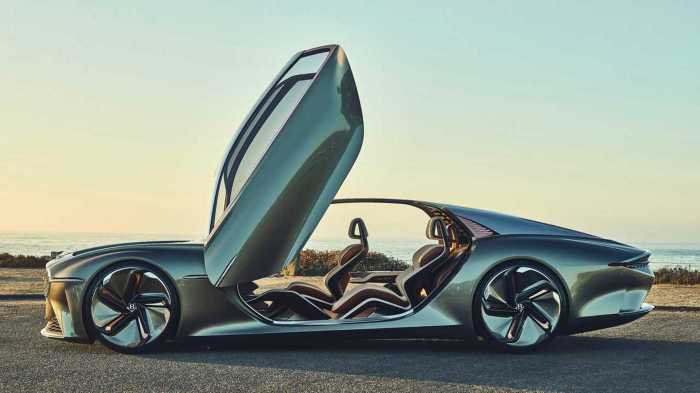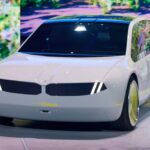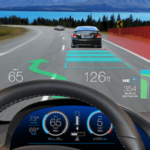Best luxury cars with autonomous driving 2025? It’s a question on everyone’s mind! Imagine cruising in a self-driving luxury ride, leaving the stress of traffic and parking behind. This deep dive explores the top contenders in the luxury autonomous driving market for 2025, examining the tech, safety, user experience, and of course, the price tag. We’ll unpack what “luxury” and “autonomous” even mean in 2025 and look at the future of this exciting sector.
From the cutting-edge sensor fusion and AI powering these vehicles to the luxurious interiors designed for ultimate comfort during autonomous travel, we’ll cover it all. We’ll also analyze the safety features and reliability of these systems, addressing common concerns and exploring potential challenges. Get ready to explore the future of driving – the luxurious, autonomous future.
Defining “Luxury” and “Autonomous Driving” in 2025

Luxury in the automotive world is undergoing a significant transformation. In 2025, it’s less about simply showcasing opulence through materials like leather and wood, and more about a holistic experience encompassing technology, sustainability, and personalized comfort. Consumers are increasingly valuing seamless integration of advanced tech, personalized experiences, and features that enhance convenience and efficiency, alongside the traditional hallmarks of luxury.
Think sophisticated infotainment systems, advanced driver-assistance features, and sustainable materials that reflect a commitment to environmental responsibility.The definition of “autonomous driving” is also nuanced. It’s not a binary on/off switch but rather a spectrum of capabilities defined by the Society of Automotive Engineers (SAE) levels. These levels represent incremental increases in automation, from driver assistance to fully self-driving capabilities.
Understanding these levels is crucial for grasping the implications for luxury car manufacturers and consumers in 2025.
Autonomous Driving Levels and Their Relevance to Luxury Cars in 2025
The SAE levels provide a framework for understanding the varying degrees of automation in vehicles. Higher levels signify greater autonomy, and in the luxury market, these levels translate to different price points and consumer expectations.
| SAE Level | Description | Features | Luxury Car Example (2025 Projection) |
|---|---|---|---|
| Level 0: No Automation | The driver is responsible for all aspects of driving. | Basic safety features like anti-lock brakes (ABS) and electronic stability control (ESC). | While unlikely to be marketed as a “luxury” car in 2025, some basic models might still exist. |
| Level 1: Driver Assistance | The vehicle can assist the driver with some aspects of driving, but the driver remains in control. | Adaptive cruise control, lane keeping assist, automatic emergency braking. | Entry-level luxury SUVs might offer robust Level 1 features as standard. |
| Level 2: Partial Automation | The vehicle can control both steering and acceleration/braking under certain conditions, but the driver must remain attentive and ready to take control. | Hands-on driver-assistance systems like Tesla’s Autopilot or GM’s Super Cruise (with limitations). | Most luxury sedans and SUVs will likely offer advanced Level 2 systems with enhanced features and wider operational ranges. |
| Level 3: Conditional Automation | The vehicle can control all aspects of driving under certain conditions, but the driver must be ready to take control when prompted. | Systems capable of handling more complex driving scenarios, potentially including highway driving in good weather conditions. The driver might be able to disengage from the driving task entirely under specific circumstances, but must be ready to resume control. | High-end luxury models might offer Level 3 capabilities, though widespread adoption might be limited due to regulatory hurdles and safety concerns. |
| Level 4: High Automation | The vehicle can control all aspects of driving under certain conditions, without the need for driver intervention. | Fully self-driving capabilities in limited geographical areas or under specific conditions (e.g., geofenced areas). | Limited availability in 2025, possibly as an optional feature on flagship models in specific regions. |
| Level 5: Full Automation | The vehicle can control all aspects of driving under all conditions, without the need for driver intervention. | Complete self-driving capability in all environments. | Highly unlikely to be commercially available in 2025. |
Top Contenders
Okay, so we’ve defined luxury and autonomous driving – now let’s dive into the heavy hitters expected to be leading the pack in 2025. We’re talking about the brands pushing the boundaries of self-driving tech while still delivering that premium, luxurious experience. It’s a pretty exclusive club.Predicting the future is always tricky, but based on current development and announced plans, we can make some educated guesses about who will be at the forefront of autonomous luxury vehicles in 2025.
These brands are investing heavily in R&D and already have impressive systems in place, paving the way for more advanced capabilities in the coming years.
Leading Luxury Brands and Their Autonomous Driving Systems
The following list compares five major luxury automakers and their projected autonomous driving capabilities in 2025. Remember, this is based on current trends and announcements; the automotive landscape is constantly evolving.
- Tesla: Tesla’s Autopilot system is already widely known, though its level of autonomy is still debated. By 2025, they aim for a fully autonomous system (Level 5), relying heavily on their extensive data collection and neural network-based approach. Strengths: Extensive data, rapid software updates, relatively affordable (compared to other luxury brands). Weaknesses: Safety concerns remain due to past accidents, overreliance on sensor technology, potential for overconfidence in the system by drivers.
- Mercedes-Benz: Mercedes-Benz is pushing hard with their DRIVE PILOT system, focusing on advanced driver-assistance systems (ADAS) and aiming for conditional automation (Level 3). They emphasize safety and a more conservative approach compared to Tesla. Strengths: Strong emphasis on safety, robust sensor fusion, integration with high-end luxury features. Weaknesses: Slower rollout of full autonomy compared to Tesla, potentially higher cost.
- BMW: BMW’s autonomous driving efforts are focused on a gradual approach, integrating ADAS features into their vehicles. By 2025, expect significant advancements in their driver-assistance capabilities, potentially reaching Level 3 in specific scenarios. Strengths: Focus on seamless integration with existing driving dynamics, strong reputation for engineering. Weaknesses: May not achieve full Level 5 autonomy by 2025, slower pace of development compared to Tesla.
- Audi: Audi, part of the Volkswagen Group, is also working on highly automated driving features, aiming for Level 3 autonomy by
2025. Their focus is on combining advanced sensors with highly detailed map data for precise navigation and control. Strengths: Strong technological base within the VW Group, integration with other VW brands’ technologies. Weaknesses: Potential for delays due to the complexities of coordinating development across multiple brands.So, you’re looking at the best luxury cars with autonomous driving for 2025? That’s a pretty hot topic, especially considering the environmental impact of manufacturing. It makes you wonder about the whole supply chain, like how sustainable the production really is, which is why I checked out this article on How green is Tesla’s Gigafactory production? It’s a key factor when choosing a luxury EV, right?
Ultimately, the greenest car is the one you don’t buy, but if you’re gonna get a self-driving luxury ride, understanding the manufacturing process is key.
- General Motors (Cadillac): GM’s Super Cruise system is already a competitive offering, and by 2025, they aim to expand its capabilities and geographical coverage, moving towards higher levels of automation. Strengths: Strong existing system with proven capabilities, integration with other GM brands. Weaknesses: May lag behind Tesla and Mercedes-Benz in achieving full autonomy, geographical limitations.
Technological Aspects of Autonomous Driving in Luxury Cars: Best Luxury Cars With Autonomous Driving 2025

The race to perfect autonomous driving is heating up, and luxury car manufacturers are at the forefront, leveraging cutting-edge technology to deliver unparalleled driving experiences. These advancements go beyond simple driver-assist features; they represent a fundamental shift in how we interact with and experience vehicles. The integration of sophisticated systems is key to achieving the high levels of safety and reliability expected in luxury cars.The core technologies powering autonomous driving in luxury vehicles are complex and interconnected.
Success hinges on seamless collaboration between various systems. These technologies are constantly evolving, with significant improvements anticipated in the coming years.
Sensor Fusion
Sensor fusion is the process of combining data from multiple sensors to create a more complete and accurate understanding of the vehicle’s surroundings. Luxury vehicles typically employ a suite of sensors, including LiDAR (Light Detection and Ranging), radar, cameras, and ultrasonic sensors. LiDAR provides high-resolution 3D mapping of the environment, while radar excels in detecting objects in low-light conditions or through adverse weather.
Cameras offer visual information, crucial for object recognition and lane keeping, and ultrasonic sensors detect nearby obstacles for parking assistance. The fusion of data from these diverse sources allows the autonomous driving system to create a robust and reliable picture of its environment, even in challenging conditions. For example, Tesla’s Autopilot system utilizes a combination of cameras, radar, and ultrasonic sensors, constantly updating its perception of the surroundings.
Artificial Intelligence (AI) and Machine Learning, Best luxury cars with autonomous driving 2025
AI and machine learning are indispensable for autonomous driving. These technologies power the decision-making capabilities of the system, enabling it to interpret sensor data, predict the behavior of other road users, and plan safe and efficient driving maneuvers. Deep learning algorithms, trained on massive datasets of driving scenarios, are crucial for object recognition, lane detection, and path planning. Luxury brands often invest heavily in AI research and development, customizing algorithms for their specific vehicle designs and driving characteristics.
For instance, Waymo’s self-driving technology utilizes sophisticated AI algorithms to navigate complex urban environments, learning from millions of miles of driving data.
High-Definition (HD) Mapping
Precise and detailed maps are essential for autonomous navigation, especially in complex environments. HD maps go beyond standard GPS data, providing centimeter-level accuracy of road features, lane markings, traffic signs, and other relevant information. This high level of detail allows the autonomous driving system to precisely locate itself within its environment and plan its trajectory with confidence. Luxury car manufacturers often collaborate with mapping companies to create custom HD maps tailored to their vehicles’ capabilities and the regions they operate in.
For example, Mercedes-Benz utilizes highly detailed maps in its autonomous driving systems, enabling precise lane positioning and navigation even in challenging urban settings.
Innovative Technologies in Luxury Brands
Several luxury brands are pushing the boundaries of autonomous driving technology. For example, some manufacturers are integrating advanced driver monitoring systems that utilize cameras and AI to detect driver fatigue or distraction, automatically intervening if necessary. Others are developing highly personalized autonomous driving experiences, adapting the driving style to the individual preferences of the driver. Furthermore, some luxury cars are equipped with sophisticated in-car entertainment and communication systems that seamlessly integrate with the autonomous driving features, enhancing the overall passenger experience.
These technologies are not just about the journey but also about the experience. They strive to make the experience more relaxing, comfortable, and productive.
Safety and Reliability of Autonomous Systems
The safety and reliability of autonomous driving systems in luxury vehicles are paramount, representing a significant hurdle in the transition to widespread adoption. Manufacturers are employing diverse strategies to ensure these systems are not only technologically advanced but also demonstrably safe and dependable, addressing concerns about potential failures and unexpected situations. These efforts involve rigorous testing, advanced sensor fusion, and fail-safe mechanisms designed to mitigate risks.Manufacturers utilize a variety of safety features and reliability testing procedures.
These differ based on their specific technological approaches and internal safety standards. While precise details of internal testing are often proprietary, public information reveals a general pattern of increasingly stringent testing protocols.
Autonomous System Redundancy and Fail-Safe Mechanisms
Luxury car manufacturers are investing heavily in redundant systems to enhance safety. This means incorporating multiple independent sensors, processors, and actuators that can take over if one component fails. For example, a vehicle might rely on a combination of lidar, radar, and cameras to perceive its surroundings. If one sensor malfunctions, the others can compensate, preventing a complete system failure.
Furthermore, fail-safe mechanisms are built-in to ensure the vehicle can safely pull over or come to a controlled stop if a critical system failure occurs. These mechanisms might involve automatically engaging the brakes, activating hazard lights, and sending an alert to emergency services. Tesla’s Autopilot, for instance, uses multiple cameras and radar to detect obstacles, and if a critical failure occurs, it is designed to gradually slow the car to a stop.
Similarly, Mercedes-Benz’s Drive Pilot utilizes a sophisticated sensor fusion approach and incorporates multiple backup systems to ensure safety.
Comparative Analysis of Testing Procedures
While specific details are confidential, a general comparison can be made. Manufacturers typically subject their autonomous systems to extensive simulations, testing in controlled environments, and real-world testing on public roads. Simulation allows for testing of millions of scenarios without real-world risks. Controlled environments like test tracks enable focused testing of specific functionalities, such as lane keeping or object detection.
Real-world testing, though more challenging, provides invaluable data on how the system performs in unpredictable conditions. The volume and rigor of these tests vary across manufacturers, influencing the level of confidence in their respective autonomous driving systems. Some manufacturers might emphasize simulation, while others might place greater emphasis on real-world testing. The precise balance depends on their internal risk assessments and development strategies.
Okay, so you’re looking at the best luxury cars with autonomous driving in 2025? That’s a pretty sweet ride! But range is also key, especially if you’re going on a long road trip. Check out this list of Luxury electric cars with longest range 2025 to make sure you find a car that can keep up with your self-driving adventures.
Ultimately, the best luxury autonomous car for you will depend on balancing those features.
Hypothetical Safety Challenge and Proposed Solutions
Imagine a scenario: a luxury SUV equipped with Level 4 autonomous driving is navigating a busy city intersection during a heavy downpour. The rain significantly reduces visibility, obscuring the sensors’ ability to accurately detect a pedestrian unexpectedly darting into the street. The autonomous system misinterprets the situation due to the reduced sensor data.Several solutions could mitigate this risk.
Improved sensor fusion algorithms could be developed to better handle low-visibility conditions by integrating data from multiple sensors more effectively and weighting the information based on reliability under specific circumstances. Advanced machine learning techniques, trained on extensive datasets of adverse weather conditions, could enhance the system’s ability to identify and respond to unexpected events. The integration of advanced weather sensors could provide real-time information to the autonomous system, allowing for preemptive adjustments in driving behavior.
Furthermore, including a robust human override system that allows the driver to quickly take control in emergency situations would be a critical safeguard.
The User Experience
Okay, so we’ve talked about the tech behind self-driving luxury cars – now let’s get into the
- vibe*. The whole point of a luxury autonomous vehicle isn’t just getting from point A to point B; it’s about the
- experience* of the journey. This means the interior design and how you interact with the car are crucial.
The interior design of a luxury autonomous vehicle in 2025 will prioritize passenger comfort and seamless interaction with the vehicle’s systems. Imagine sinking into plush, sustainably sourced leather seats that adjust to your exact body shape with the touch of a button. Ambient lighting subtly shifts throughout the day, mimicking the natural light outside, while a panoramic sunroof floods the cabin with sunshine.
Large, curved displays elegantly integrated into the dashboard showcase information, entertainment, and control options with crystal-clear resolution. Instead of a traditional steering wheel, a minimalist control interface allows for intuitive interaction with the car’s functions, like adjusting climate control or selecting music. High-quality materials like polished wood and brushed aluminum add to the overall luxurious feel. The floor is carpeted in a soft, sound-dampening material, further enhancing the quiet and serene atmosphere.
Interior Design Elements Contributing to Passenger Comfort
The design of these interiors directly impacts passenger comfort and enjoyment. Think of it as a mobile living room or personal sanctuary. The spaciousness allows for comfortable movement and legroom, even with the absence of a traditional driver’s area. Ergonomic seating minimizes fatigue during long journeys, and advanced climate control systems maintain a perfectly comfortable temperature. Noise-cancellation technology ensures a peaceful ride, unmarred by outside distractions.
The materials chosen are not only aesthetically pleasing but also tactilely comfortable and designed to be durable and easy to clean. Imagine the soft touch of Alcantara on the armrests, or the cool smoothness of a temperature-controlled cup holder. These seemingly small details add up to create a luxurious and relaxing experience.
Cost and Market Accessibility

The price tag for a luxury car boasting advanced autonomous driving capabilities in 2025 is expected to be significantly higher than its non-autonomous counterpart. This premium reflects the substantial investment in research, development, and the sophisticated technology involved. Factors like the complexity of sensor systems, powerful computing hardware, and the software required for safe and reliable autonomous operation all contribute to the elevated cost.The market accessibility of these vehicles will be influenced by a complex interplay of price, technological limitations, and consumer demand.
While the technology continues to advance, the initial cost of entry for these vehicles will likely limit their reach to a relatively affluent segment of the population. Technological limitations, such as inconsistent performance in challenging weather conditions or unexpected scenarios, could also impact consumer confidence and, consequently, market penetration. Conversely, strong consumer demand driven by safety concerns, convenience, or technological fascination could push manufacturers to increase production and potentially lower prices over time.
Price Range Projections
Luxury vehicles equipped with Level 3 or higher autonomous driving features in 2025 are projected to fall within a broad price range, likely starting around $100,000 and extending well beyond $250,000 depending on the brand, model, and specific features included. This is a significant increase compared to similarly equipped vehicles lacking autonomous driving capabilities. For example, a high-end sedan without autonomous features might retail for $80,000, while its autonomous counterpart could easily command a $120,000 price tag or more.
This price difference reflects the substantial cost of the advanced technology integrated into the vehicle.
Factors Affecting Market Penetration
Several key factors will determine how quickly these autonomous luxury vehicles become mainstream. The high initial purchase price will undoubtedly restrict access primarily to high-income individuals and businesses. Technological limitations in real-world application, particularly in diverse and unpredictable driving environments, could hinder consumer adoption. Consumer perception of safety and reliability will be crucial; negative incidents or reports could significantly impact market confidence.
Furthermore, the availability of supporting infrastructure, such as robust mapping data and reliable network connectivity, will also play a role in determining market accessibility. Finally, government regulations and safety standards will shape the pace of adoption, influencing both the cost and the availability of these vehicles. For instance, stricter safety regulations might lead to higher production costs, thereby further limiting market accessibility.
Future Trends and Predictions
Predicting the future of autonomous driving in luxury cars is a complex but fascinating endeavor. The next five years will likely see significant advancements, driven by both technological breakthroughs and evolving consumer expectations. We’ll see a shift from largely driver-assistance systems to more sophisticated levels of automation, with a corresponding impact on the design and experience of luxury vehicles.The convergence of several key technologies will shape the autonomous driving landscape.
These include advancements in sensor technology, artificial intelligence, high-definition mapping, and robust cybersecurity measures. The interplay of these elements will determine the speed and safety of autonomous system deployment, directly impacting the luxury car market’s trajectory.
Increased Sensor Fusion and AI Refinement
The accuracy and reliability of autonomous systems heavily depend on the quality and quantity of data gathered from various sensors. We’re likely to see a substantial increase in the use of sensor fusion, combining data from LiDAR, radar, cameras, and ultrasonic sensors to create a more comprehensive and robust understanding of the vehicle’s surroundings. Simultaneously, advancements in artificial intelligence, particularly deep learning algorithms, will enable more sophisticated processing of this data, leading to improved decision-making capabilities in complex driving scenarios.
For instance, imagine a system that can not only detect a pedestrian but also predict their trajectory and react accordingly, even in low-light conditions or amidst heavy traffic. This level of predictive capability will be crucial for achieving higher levels of autonomy.
Enhanced High-Definition Mapping and Infrastructure Integration
High-definition (HD) maps are becoming increasingly crucial for autonomous driving. These maps provide incredibly detailed information about the road network, including lane markings, traffic signs, and even the location of obstacles. The next five years will see an expansion of HD map coverage, particularly in densely populated urban areas. Furthermore, the integration of autonomous driving systems with smart city infrastructure, such as traffic light communication systems, will allow for smoother and more efficient navigation.
This collaborative approach will optimize traffic flow and enhance the overall driving experience, particularly in congested urban environments. For example, a luxury vehicle might receive real-time information about upcoming traffic jams or construction zones, allowing the autonomous system to proactively adjust its route and speed, minimizing delays.
Focus on Cybersecurity and System Reliability
As autonomous systems become more sophisticated, the need for robust cybersecurity measures will become even more critical. Luxury car manufacturers will invest heavily in protecting their vehicles from hacking attempts and other security threats. This will involve implementing advanced encryption techniques, intrusion detection systems, and regular software updates to address vulnerabilities. Moreover, the reliability of autonomous systems is paramount, and manufacturers will prioritize fail-safe mechanisms and redundancy measures to ensure that vehicles can safely handle unexpected situations or system failures.
For instance, a system might automatically transition to a lower level of automation or safely bring the vehicle to a stop if a critical sensor malfunctions. This emphasis on reliability will be essential to building consumer trust and confidence in autonomous driving technology.
Evolution of the User Experience
The user experience within autonomous vehicles will undergo a significant transformation. The interior of luxury cars will be redesigned to optimize passenger comfort and productivity during autonomous driving. We might see features such as reclining seats, interactive entertainment systems, and enhanced connectivity options. The design will shift from a driver-centric approach to a more passenger-centric one, allowing occupants to utilize their travel time for work, relaxation, or socializing.
Think of a luxury sedan transforming into a mobile office or entertainment center, providing a seamless transition between travel and productivity.
Final Conclusion
So, are you ready to experience the future of luxury driving? 2025 promises a revolution in how we travel, with autonomous features transforming the luxury car market. While challenges remain, the innovations we’ve discussed highlight a thrilling trajectory toward a future where comfort, convenience, and safety seamlessly blend. The race is on amongst luxury brands to deliver the ultimate self-driving experience, and the coming years will be crucial in shaping this exciting landscape.
Buckle up!









